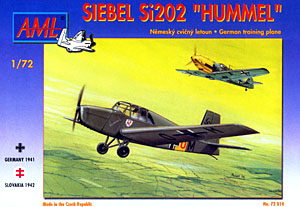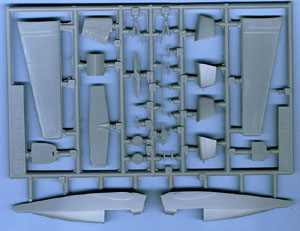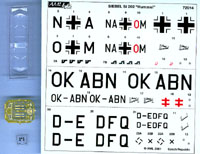AML's 1/72 Siebel Si 202 'Hummel' |  | History Trying to find references for the historical overview of the Siebel Si 202 is not an easy task. In fact, after checking several references all I was able to turn up was a couple small photos. Basically the plane was designed for light sport and basic training duties. A handful were produced in three different variants, with the differences being in the engine used. The plane served through to the end of the Second World War. The Kit  Kits of Siebel aircraft are few and far between, so AML's kit of the Si 202 is a very welcome one for Luftwaffe enthusiasts. You get a single tree of gray plastic parts, a small photoetch fret, a vacuformed canopy and a fairly large decal sheet. The plastic parts are in AML's usual soft plastic, with recessed panel lines throughout and fairly decent detailing throughout. Kits of Siebel aircraft are few and far between, so AML's kit of the Si 202 is a very welcome one for Luftwaffe enthusiasts. You get a single tree of gray plastic parts, a small photoetch fret, a vacuformed canopy and a fairly large decal sheet. The plastic parts are in AML's usual soft plastic, with recessed panel lines throughout and fairly decent detailing throughout.
Starting with the interior, you get a bench seat, a rear bulkhead, and a forward bulkhead, all fitting into the fuselage halves. There is no separate cockpit floor, and seatbelts are provided in photoetch. Also on the photoetch fret is the instrument panel in two pieces, with film instruments. Control sticks round out the interior. The lack of a cockpit floor will be a problem, as there will be a very noticable seam running down the middle. A piece of plastic card will cover this up, and some extra detailing on it wouldn't look out of place (like rudder pedals). The kit comes with two choices of nose cowlings, one for the Si 202 and one for the Si 202C. Once you make your choice of cowlings, the rest of the assembly is very straightforward. The wings are solid right and left halves, as are the tailplanes. The landing gear looks solid enough, but you'll want to spend some time cleaning up the parts and making sure the struts are round. The canopy piece incorporates the upper section of the fuselage, so you'll want to mask off the windows beforehand to protect them during the assembly and painting process.  For painting, the decal sheet offers three choices, two Luftwaffe and one Slovak. The two Luftwaffe examples are finished in overall RLM 63. The first dates from June 1939 and has the red tail band from that period. Civil registration codes are also carried on the fuselage sides and wings. The other Luftwaffe example is from 8./JG 2 and has a yellow fuselage band and the JG 2 unit badge under the windscreen. Standard crosses are present in all the usual places. The final example is from the Slovak Air Force in the summer of 1940 and is finished in overall aluminum. The civil codes are on the fuselage sides and wings, while the tail has a blue band with a red double cross centered in a white circle. All three planes have Hummel written on the fuselage sides. The decals are well printed and in excellent register. For painting, the decal sheet offers three choices, two Luftwaffe and one Slovak. The two Luftwaffe examples are finished in overall RLM 63. The first dates from June 1939 and has the red tail band from that period. Civil registration codes are also carried on the fuselage sides and wings. The other Luftwaffe example is from 8./JG 2 and has a yellow fuselage band and the JG 2 unit badge under the windscreen. Standard crosses are present in all the usual places. The final example is from the Slovak Air Force in the summer of 1940 and is finished in overall aluminum. The civil codes are on the fuselage sides and wings, while the tail has a blue band with a red double cross centered in a white circle. All three planes have Hummel written on the fuselage sides. The decals are well printed and in excellent register.
Conclusion While you'll have to keep in mind the short-run production style of this kit, a nice replica of the Si 202 can be built from this kit, which is good considering that this is the only injection Si 202 out there. The soft plastic will show mistakes more easily, and the monotone color schemes will accentuate this, but with care you can fill an important niche in your Luftwaffe collection. | 

 



|
